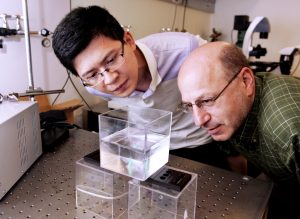Study Shows Bursting Bubbles Can Redistribute Oil Droplets into a Water Column
– October 14, 2014
Scientists using a high-speed camera to observe bubbles bursting have gained new insight into the hydrodynamics of complex fluids.
They found that collapsing bubbles emit a downward spray into the water and that the presence of a surfactant can facilitate the transport of tiny, submicron-diameter oil droplets into the underlying water column. While this phenomenon could increase pollutant distribution, it could also be a useful and cost-efficient dispersal method with industrial and oil biodegradation applications. The team published their findings in the August 2014 edition of Nature Physics: Nanoemulsions obtained via bubble-bursting at a compound interface.
The authors reported that bubbles in an oil-water interface are covered by two film layers – a water film that forms the bubble cap covered by an oil film – and burst in two steps. First, the top oil film breaks and retracts. A hole then forms in the water film, and the bubble cap ruptures and retracts. The bubble walls collapse inward and the surrounding fluids converge, pushing the flow down and ejecting a spray from the bottom of the bubble, projecting the oil droplets into the water below.
Researchers replicated the bubble-bursting process by releasing air from the bottom of a tank of water with a thin top layer of either oil or surfactant-oil mixture. A camera operating at 6,800 – 32,000 frames per second captured each stage of the bursting bubbles. They identified and measured small droplets that traveled down into the water column using dynamic light scattering – a process that analyzes fluctuations in the intensity of scattered laser light to determine particles’ size.
The team also examined the behavior and fate of the newly formed droplets. They observed that larger oil droplets rose back to the surface, while smaller droplets remained deep in the water column. The small droplets’ size remained constant for at least a week, indicating that they were stable. The smaller droplets appeared only when surfactant was present in the water phase. They concluded that hydrodynamics did not affect the size of these droplets, because heightened energy in and resulting from the collapse increased droplet size rather than decreasing it. Therefore, the physical chemistry of interactions between oil and surfactant molecules determined droplet size.
The researchers suggested that increasing bubble frequency could easily scale this dispersal method, potentially offering a low-cost, sustainable method of dispersing tiny particles under various interfacial tensions. “This system offers an energy-efficient route to produce nanoparticles […] for applications in a variety of fields such as drug delivery, food production, and materials science,” explained researcher Jie Feng.
The team also acknowledged the complexities of this top-down method. Bubble-bursting can continue to disperse oil into the water column when other mechanisms, such as wave breaking, are limited. This redistribution of oil particles could make toxins more available for ingestion by sea creatures. But, the droplets’ small size could also speed up pollutant biodegradation by hydrocarbon-eating bacteria.
The study’s authors are Jie Feng, Matthieu Roché, Daniele Vigolo, Luben N. Arnaudov, Simeon D. Stoyanov, Theodor D. Gurkov, Gichka G. Tsutsumanova, and Howard A. Stone.
This research was made possible in part by a grant from BP/The Gulf of Mexico Research Initiative (GoMRI) to the Consortium for the Molecular Engineering of Dispersant Systems (C-MEDS). Other funding sources included EU project Beyond Everest (FP7-REGPOT-2011-1).
The GoMRI is a 10-year independent research program established to study the effect, and the potential associated impact, of hydrocarbon releases on the environment and public health, as well as to develop improved spill mitigation, oil detection, characterization, and remediation technologies. An independent and academic 20-member Research Board makes the funding and research direction decisions to ensure the intellectual quality, effectiveness and academic independence of the GoMRI research. All research data, findings and publications will be made publicly available. The program was established through a $500 million financial commitment from BP. For more information, visit https://gulfresearchinitiative.org/.
© Copyright 2010- 2017 Gulf of Mexico Research Initiative (GoMRI) – All Rights Reserved. Redistribution is encouraged with acknowledgement to the Gulf of Mexico Research Initiative (GoMRI). Please credit images and/or videos as done in each article. Questions? Contact web-content editor Nilde “Maggie” Dannreuther, Northern Gulf Institute, Mississippi State University (maggied@ngi.msstate.edu).






